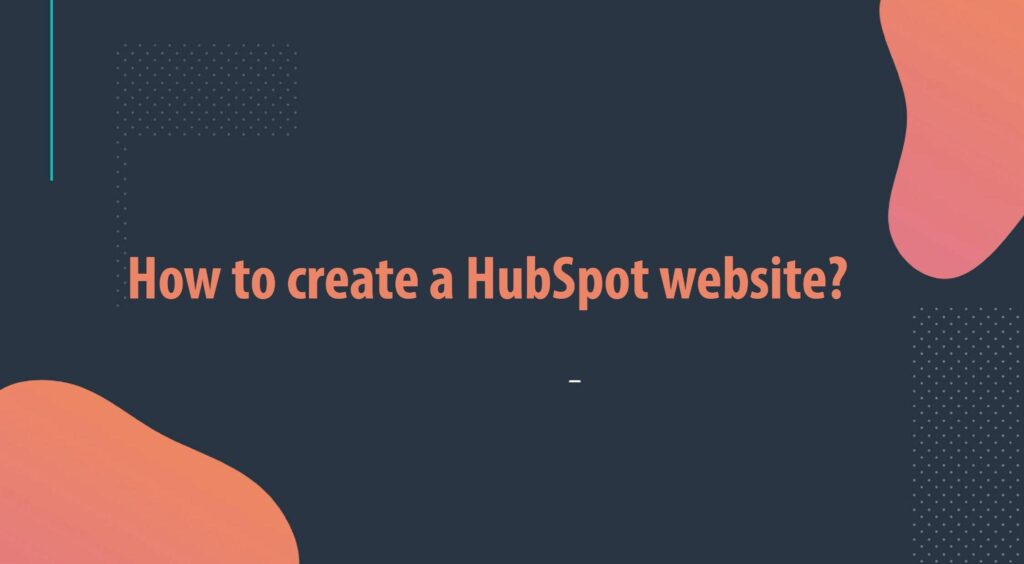Welcome to the universe of HubSpot. Here is a guide in which you can learn how you can build and manage a website on the HubSpot CMS platform. With this, you’ll have the option to open a huge number of chances and advantages for your business.
Pretty much every business needs a website. It’s basically impossible to get around it. Put yourself in the shoes of one of your clients and envision how they could find your image nowadays.
There’s a purchaser’s excursion that happens for every single help or item given by organizations. Adding a thing to a truck and making a buy – from a metaphorical perspective – is basically the finish of this excursion.
Purchasers must be met with a progression of legitimate and enthusiastic requests so they can guarantee that anything you’re offering can satisfy their necessities. Your substance, the content management system (CMS) is one method for directing the client experience through these requests.
Let’s look into it.
What is HubSpot CMS
With the help of CMS we can create, manage, and host content online.
HubSpot CMS is a content management system for sites with a unique accentuation on lead generation and sustaining. The platform is intended to make blogs, websites, landing pages, lightweight applications, and emails.
Dissimilar to different systems, the CMS Hub was expressly evolved to rearrange dealing with your site (very much like the organization did with its different items). Additionally, some of them are enveloped with the stage, as well.
Additionally, the CMS Hub is incredible for content personalization since it permits you to segment leads, track their movement, and send customized content at a specific time.
Types of CMS you have:
1. CMS Hub Professional:
$300/month to “Assemble an adaptable site that non-technical marketer can update.” You can make webpages, develop traffic and convert leads, and secure your site with this choice.
2. CMS Hub Enterprise:
$900/month to “Gain more noteworthy site controls and the ability to construct web applications.” This choice permits you to assemble strong web application experiences, gain scalable administration, and stretch out your brand in addition to the previously mentioned features.
HubSpot CMS benefits
1. Fast, safe and confident
HubSpot development service(s) offer service security. All processes are shielded from outside influences, allowing teams to focus on developing a hands-on user experience. In addition, the platform intelligently introduces a global Content Delivery Network (CDN). This speeds up page loading wherever the visitor is located.
2. Developer friendly and flexible for marketers
The platform allows developers to build websites using their favorite tools, technologies, and workflows. The platform is also interested in marketers who can use simple drag-and-drop tools to create pages and publish content. In addition, templates and modules as building blocks empower developers to make adaptable design systems by content makers.
3. Combining CRM and CMS
HubSpot CMS coordinates flawlessly with the CRM system, which permits the organization to make customized marketing sites for its visitors.
4. Free trial
You can begin working with the platform free of charge by joining into a free trial term. It is expected for experienced designers or developers.
5. It converts content marketing into a traffic generator
HubSpot provides brand development features for an unlimited number of users. Here’s how you can customize reports to track sales activity and track deal progress. These reports allow clients to adjust their strategies.

How to create a HubSpot website
Honestly creating a HubSpot website is the Simple and easy step. Ensuring good performance, attracting, engaging and satisfying customers so that they come back for more purchases is a difficult part.
1. Plan and strategy
The scientific trend is valid to this day. At first we identify the problem. If you know what you are trying to solve, start by identifying your goals and planning how to achieve them.
Take the time to create a content strategy that aligns with our business goals. A content technique ought to spin around your audience and your brand. Think consciously about the role search engine optimization (SEO) will play in your content. Hope this is great.
2. Create metrics
Depending on the goals you plan to achieve, you’ll want to get a better idea of what kind of metrics you need to measure to track progress. This will look like traffic, leads, reach, clicks, and more.
3. Choose a template
HubSpot has many templates. You can browse the overflow however on the off chance that not, you can likewise make your own template. The attractiveness of your website should be paramount to maintaining the integrity of your business.
Building a website is all about building brand awareness. But a brand must be unique. Use HubSpot CMS to create a unique and aesthetic website for your content.
4. Add content
This is probably the most important part. Furthermore, HubSpot CMS is a content management system. The decision here is a bit difficult because the type of content you produce depends entirely on your industry.
Another thing to consider is how your writing will look in terms of spelling, tone, style, and other literary elements that can affect how readers interpret your content.
Some blogs aim to sell outright. Others are centers of specialized knowledge through professional tone. And many blogs use informality to communicate with readers, but convey meaning nonetheless.
5. Integrate CRM
Most, if not all, of HubSpot’s main benefits come from its CRM. There are options in hubspot development services for integrating HubSpot CMS with other CRM software such as Salesforce or Marketo, but most HubSpot professionals compete to get the best HubSpot at home from both worlds.
Either way, CRM is a great way to see the sales and marketing world of your business. Needless to say, it is essential for the growth of your business.
6. Purification and testing
HubSpot has a content display area where you can test your website before publishing. Ideally, make sure everything works. In addition, when you start posting, you will see what works and what does not work with your website. Adjust accordingly.
Migrating Content From Another CMS To HubSpot
HubSpot is getting increasingly more famous constantly. In any case, there are many strays who need to partake in the advantages of HubSpot CMS yet don’t have the foggiest idea how to move their content.
The process is complex in nature. There are numerous things to hold under control, for example,
- Keeping up with URL structures on sites
- diverting URLs to new destinations
- keeping pages uniform and their depictions coordinating
- keeping similar HTML markups like alt text and header types
- executing space sending
Interestingly, the real movement process is genuinely straightforward. Leastways, it seems to be that on paper. The analysis is as follows:
- Whether you choose from ready-made templates or hire a developer to create a custom template for you, set up a HubSpot template for your website.
- Transfer data from your current CMS into an XML file. This document must contain all content metadata, including title, post, URL, author, data, tags, categories, meta description, featured images, and comments.
- Finally, blog posts are imported into HubSpot CMS.
Although the migration process consists of only three steps, there are some heavy tasks to perform in each step. Companies often hire developers to handle this part and mitigate risk.
How does CMS Hub handle website management?
Let’s take a look at the updated features available in CMS Hub Professional & Enterprise and how they make it easy to build great web interfaces for your customers.
Testing multilingual page

CMS Hub makes it simple to oversee content in various dialects. This element permits you to run A/B testing and responsive pages. When you install CMS Hub Enterprise, you can also run responsive page tests on all content. Additionally, you can perform machine learning for automated testing. This allows you to tailor the selected page to a specific audience.
Dynamic content using HubDB
Using HubDB, you can create web pages that link to content from your spreadsheets. As the data in the table changes, the content on your site also updates. CMS Hub Professional is powered by HubSpot CRM allowing you to create and extend custom content.
Create personalized content
This service consists of providing each visitor with website content designed specifically for him. Providing individual recommendations to your customers allows access to higher quality content. By joining CMS Hub Enterprise, you can create tailor-made content for each site visitor.
For example, it could be the “My Events” page that you want to show to a specific audience. With CMS Hub Enterprise you can set up customized content that shows all the events in which one of your customers has been involved in the past in your company.
You work without a server

The additional features of CMS Hub Enterprise help you build powerful web applications that extend performance. For example, you never again need to physically compute what an adjustment of traffic can mean for your exhibition and design the server best.
Activity logs
The expansion of the business prompts the requirement for steady manipulation and updating of your site. As the quantity of individuals in the group develops, following the site update turns out to be more vital. Action logs at CMS Hub Enterprise let you see what changes are going on your whole site and who made them. You don’t need to physically make it happen.
Company Domain
As your brand grows, you need to build some websites. For example, it can be a matter of merging small locations of a specific department or expanding them into two business areas. CMS Hub Enterprise allows you to create brands with more than one brand domain (if required). The advantage is that a report is generated for each site. This way you don’t have to affect multiple systems depending on the needs of your website.
Author Bio:
Rajan
SEO Executive
 This blog is written by Rajan who is employed in a web and app development company, where you can also hire dedicated full stack developers. He personally handles work related to seo, smo and email marketing works.
This blog is written by Rajan who is employed in a web and app development company, where you can also hire dedicated full stack developers. He personally handles work related to seo, smo and email marketing works.








